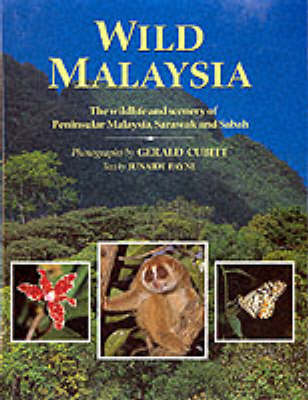Wild places of the world
2 total works
Wild Malaysia is a major new pictorial study of the natural history of southeast Asia's southernmost peninsula and offshore islands, which are home to an enormous wealth of species. Produced in association with the World Wide Fund for Nature, it is illustrated with 400 superb full-color plates taken especially for this book, of plants, insects and other invertebrates, fish, reptiles, frogs, birds, and mammals, each in its natural habitat.Wild Malaysia offers a general yet accurate introduction to this spectacularly scenic region and its national parks. Malaysia's tropical islands, topped by rainforest and ringed by coral reefs and transparent blue seas, are as beautiful and untouched as anywhere in the world. Its vast and exotic wildlife encompasses elephants and the world's smallest rhinoceros, a profusion of monkeys and apes (including proboscis and leaf monkeys, gibbons, and orangutans), the slow loris and the tarsier, the clouded leopard and the sunbear, bats and reptiles, a spectacular variety of bird and marine life, and over 10,000 species of plants.An extensive introduction examines the topography, history, climate, and peoples of Malaysia and includes important discussions of the relationship between man and forest, between conservation and development.
Sections on animal and plant life provide an overview of the multiplicity of species to be found. And in "A Walk through the Rainforest," Junaidi Payne explains the complex interdependence of the forest ecosystem, details Malaysia's conservation programs, and the plans to create new reserves and protected areas not only in the forest but on the islands and surrounding seas as well.Individual chapters describe peninsular Malaysia's islands, coastal areas, and hill forest (many of which have been designated as national parks), Sarawak's great rivers and cave systems, and Sabah's offshore islands with their coral reefs, marine life, and exotic flora. There is also a complete list of conservation areas.Gerald Cubitt is one of the world's leading natural history photographers. Junaidi Payne is a professional conservation biologist and Senior Scientific Officer with World Wide Fund Malaysia. He is coauthor with Charles M. Francis of A Field Guide to the Mammals of Borneo.
Sections on animal and plant life provide an overview of the multiplicity of species to be found. And in "A Walk through the Rainforest," Junaidi Payne explains the complex interdependence of the forest ecosystem, details Malaysia's conservation programs, and the plans to create new reserves and protected areas not only in the forest but on the islands and surrounding seas as well.Individual chapters describe peninsular Malaysia's islands, coastal areas, and hill forest (many of which have been designated as national parks), Sarawak's great rivers and cave systems, and Sabah's offshore islands with their coral reefs, marine life, and exotic flora. There is also a complete list of conservation areas.Gerald Cubitt is one of the world's leading natural history photographers. Junaidi Payne is a professional conservation biologist and Senior Scientific Officer with World Wide Fund Malaysia. He is coauthor with Charles M. Francis of A Field Guide to the Mammals of Borneo.
Published in association with the World Wide Fund for Nature, Wild India is a valuable current record of the subcontinent's wild places and wilderness areas. Guy Mountfort, an authority on all aspects of species preservation, provides a discerning account of the ecological and human history of the region, focusing on present-day pressures on India's irreplaceable natural heritage. Gerald Cubitt's superb 400 full-color photographs are informatively captioned and divided into sections on the Himalayas, the Indo-Gangetic Plain, and the Deccan. Wild India surveys the great diversity of plant and animal life from the remote Karakoram range in Ladakh to the rainforests of the southwestern ghats, from the deserts of the far west of Rajasthan to the jungles and swamps of Assam and Manipur. Here, among numerous other species, are the magnificent Kashmir stag and the shy musk deer, the rare lion-tailed macaque and the Nilgiri tahr, and the Asiatic lion--in its last bastion in the Gir forest--along with the golden langur, the one-horned rhinoceros, and herds of elephant and buffalo.

